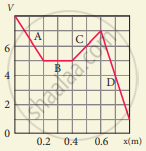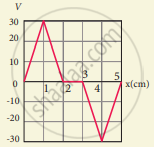Advertisements
Advertisements
प्रश्न
Give the relation between electric field and electric potential.
उत्तर
Consider a positive charge q kept fixed at the origin. To move a unit positive charge by a small distance dx in the electric field E, the work done is given by dW = -E dx. The minus sign implies that work is done against the electric field. This work done is equal to an electric potential difference. Therefore,
dW = dV.
(or) dV = -Edx
Hence E = `"dV"/"dx"`
The electric field is the negative gradient of the electric potential.
APPEARS IN
संबंधित प्रश्न
Which charge configuration produces a uniform electric field?
Rank the electrostatic potential energies for the given system of charges in increasing order.

A thin conducting spherical shell of radius R has a charge Q which is uniformly distributed on its surface. The correct plot for electrostatic potential due to this spherical shell is
Define electrostatic potential.
What is meant by electrostatic energy density?
Derive an expression for electrostatic potential due to a point charge.
Derive an expression for electrostatic potential due to an electric dipole.
Suppose a charge +q on Earth’s surface and another +q charge is placed on the surface of the Moon,
- Calculate the value of q required to balance the gravitational attraction between Earth and Moon
- Suppose the distance between the Moon and Earth is halved, would the charge q change?
(Take mE = 5.9 x 1024 kg, mM = 7.348 x 1022 kg)
Draw the free body diagram for the following charges as shown in the following figure.

The electrostatic potential is given as a function of x in figure (a) and (b). Calculate the corresponding electric fields in regions A, B, C and D. Plot the electric field as a function of x for figure (b).


